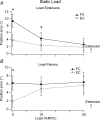Position sense at the human forearm in the horizontal plane during loading and vibration of elbow muscles
- PMID: 16873408
- PMCID: PMC1890350
- DOI: 10.1113/jphysiol.2006.115097
Position sense at the human forearm in the horizontal plane during loading and vibration of elbow muscles
Abstract
When blindfolded subjects match the position of their forearms in the vertical plane they rely on signals coming from the periphery as well as from the central motor command. The command signal provides a positional cue from the accompanying effort sensation required to hold the arm against gravity. Here we have asked, does a centrally generated effort signal contribute to position sense in the horizontal plane, where gravity cannot play a role? Blindfolded subjects were required to match forearm position for the unloaded arm and when flexors or extensors were bearing 10%, 25% or 40% of maximum loads. Before each match the reference arm was conditioned by contracting elbow muscles while the arm was held flexed or extended. For the unloaded arm conditioning led to a consistent pattern of errors which was attributed to signals from flexor and extensor muscle spindles. When elbow muscles were loaded the errors from conditioning converged, presumably because the spindles had become coactivated through the fusimotor system during the load-bearing contraction. However, this convergence was seen only when subjects supported a static load. When they moved the load differences in errors from conditioning persisted. Muscle vibration during load bearing or moving a load did not alter the distribution of errors. It is concluded that for position sense of an unloaded arm in the horizontal plane the brain relies on signals from muscle spindles. When the arm is loaded, an additional signal of central origin contributes, but only if the load is moved.
Figures





References
-
- Allen TJ, Proske U. Effect of muscle fatigue on the sense of limb position and movement. Exp Brain Res. 2006;170:30–38. - PubMed
-
- Brockett C, Warren N, Gregory JE, Morgan DL, Proske U. A comparison of the effects of concentric versus eccentric exercise on force and position sense at the human elbow joint. Brain Res. 1997;771:251–258. - PubMed
-
- Collins DF, Refshauge KM, Todd G, Gandevia SC. Cutaneous receptors contribute to kinesthesia at the index finger, elbow and knee. J Neurophysiol. 2005;94:1699–1706. - PubMed
Publication types
MeSH terms
LinkOut - more resources
Full Text Sources
Medical

